









 |
|


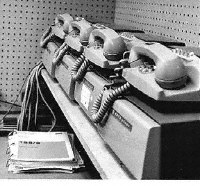 AT&T Dataphone
AT&T Dataphone
|
|
1960
AT&T designed its Dataphone, the first commercial modem, specifically for
converting digital computer data to analog signals for transmission across its
long distance network. Outside manufacturers incorporated Bell Laboratories'
digital data sets into commercial products. The development of equalization
techniques and bandwidth-conserving modulation systems improved transmission
efficiency in national and global systems.

|
|
|
|
|
1964
Online transaction processing made its debut in IBM's SABRE reservation system,
set up for American Airlines. Using telephone lines, SABRE linked 2,000
terminals in 65 cities to a pair of IBM 7090 computers, delivering data on any
flight in less than three seconds.

|
|
|
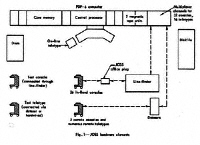 JOSS configuration
JOSS configuration
|
|
1964
JOSS (Johnniac Open Shop System) conversational time-sharing
service began on Rand's Johnniac. Time-sharing arose, in part, because the length of
batch turn-around times impeded the solution of problems. Time sharing aimed to bring
the user back into "contact" with the machine for online debugging and program
development.

|
|
|
 Acoustically coupled modem
Acoustically coupled modem
|
|
1966
John van Geen of the Stanford Research Institute vastly improved the
acoustically coupled modem. His receiver reliably detected bits of data
despite background noise heard over long-distance phone lines. Inventors
developed the acoustically coupled modem to connect computers to the telephone
network by means of the standard telephone handset of the day.

|
|
|
|
|
1970
Citizens and Southern National Bank in Valdosta, Ga., installed the country's
first automatic teller machine.

|
|
|
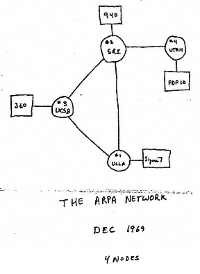 ARPANET topology
ARPANET topology
|
|
1970
Computer-to-computer communication expanded when the Department of Defense
established four nodes on the ARPANET: the University of California Santa
Barbara and UCLA, SRI International, and the University of Utah. Viewed as a
comprehensive resource-sharing network, ARPANET's designers set out with
several goals: direct use of distributed hardware services; direct retrieval
from remote, one-of-a-kind databases; and the sharing of software subroutines
and packages not available on the users' primary computer due to
incompatibility of hardware or languages.

|
|
|
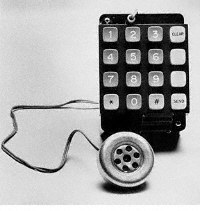 Wozniak's "blue box"
Wozniak's "blue box"
|
|
1972
Steve Wozniak built his "blue box," a tone generator to make free
phone calls. Wozniak sold the boxes in dormitories at the University of
California Berkeley where he studied as an undergraduate. "The early
boxes had a safety feature -- a red switch inside the housing operated by a
magnet taped onto the outside of the box," Wozniak remembered. "If
apprehended, you removed the magnet, whereupon it would generate off-frequency
tones and be inoperable ... and you tell the police: It's just a music
box."

|
|
|
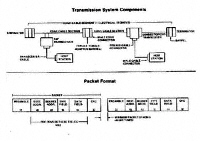 Ethernet
Ethernet
|
|
1973
Robert Metcalfe devised the Ethernet method of network connection at the Xerox
Palo Alto Research Center. He wrote: "On May 22, 1973, using my
Selectric typewriter ... I wrote ... "Ether Acquisition" ... heavy
with handwritten annotations -- one of which was "ETHER!" -- and with
hand-drawn diagrams -- one of which showed `boosters' interconnecting branched
cable, telephone, and ratio ethers in what we now call an internet.... If
Ethernet was invented in any one memo, by any one person, or on any one day,
this was it."
Robert M. Metcalfe, "How Ethernet Was Invented", IEEE Annals of
the History of Computing, Volume 16, No. 4, Winter 1994, p. 84.

|
|
|
|
|
1975
Telenet, the first commercial packet-switching network and civilian equivalent
of ARPANET, was born. The brainchild of Larry Roberts, Telenet linked
customers in seven cities. Telenet represented the first value-added network,
or VAN -- so named because of the extras it offered beyond the basic service of
linking computers.

|
|
|
|
|
1980
John Shoch at the Xerox Palo Alto Research Center invented the computer
"worm," a short program that searched a network for idle processors.
Initially designed to provide more efficient use of computers, the worm had the
unintended effect of invading networked computers, creating a security threat.
Shoch took the term "worm" from the book "The Shockwave
Rider," by John Brunner, in which an omnipotent "tapeworm"
program runs loose through a network of computers. Brunner wrote:
"No, Mr. Sullivan, we can't stop it! There's never been a worm with
that tough a head or that long a tail! It's building itself, don't you
understand? Already it's passed a billion bits and it's still growing. It's
the exact inverse of a phage -- whatever it takes in, it adds to itself instead
of wiping... Yes, sir! I'm quite aware that a worm of that type is
theoretically impossible! But the fact stands, he's done it, and now it's so
goddamn comprehensive that it can't be killed. Not short of demolishing the
net!" (247, Ballantine Books, 1975).

|
|
|
|
|
1985
The modern Internet gained support when the National Science foundation formed
the NSFNET, linking five supercomputer centers at Princeton University,
Pittsburgh, University of California at San Diego, University of Illinois at
Urbana-Champaign, and Cornell University. Soon, several regional networks
developed; eventually, the government reassigned pieces of the ARPANET to the
NSFNET. The NSF allowed commercial use of the Internet for the first time in
1991, and in 1995, it decommissioned the backbone, leaving the Internet a
self-supporting industry.
The NSFNET initially transferred data at 56 kilobits per second, an improvement
on the overloaded ARPANET. Traffic continued to increase, though, and in 1987,
ARPA awarded Merit Network Inc., IBM, and MCI a contract to expand the Internet
by providing access points around the country to a network with a bandwidth of
1.5 megabits per second. In 1992, the network upgraded to T-3 lines, which
transmit information at about 45 megabits per second.

|
|
|
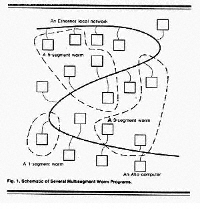 ARPANET worm
ARPANET worm
|
|
1988
Robert Morris' worm flooded the ARPANET. Then-23-year-old Morris, the son of a
computer security expert for the National Security Agency, sent a
nondestructive worm through the Internet, causing problems for about 6,000 of
the 60,000 hosts linked to the network. A researcher at Lawrence Livermore
National Laboratory in California discovered the worm. "It was like
the Sorcerer's Apprentice," Dennis Maxwell, then a vice president of
SRI, told the Sydney (Australia) Sunday Telegraph at the time. Morris was
sentenced to three years of probation, 400 hours of community service, and a
fine of $10,050.
Morris, who said he was motivated by boredom, programmed the worm to reproduce
itself and computer files and to filter through all the networked computers.
The size of the reproduced files eventually became large enough to fill the
computers' memories, disabling them.

|
|
|
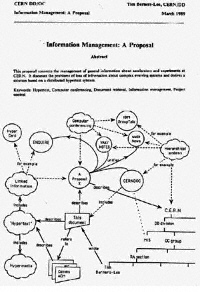 Berners-Lee proposal
Berners-Lee proposal
|
|
1990
The World Wide Web was born when Tim Berners-Lee, a researcher at CERN, the
high-energy physics laboratory in Geneva, developed HyperText
Markup Language. HTML, as it is commonly known, allowed the
Internet to expand into the World Wide Web, using specifications he developed
such as URL (Uniform Resource Locator) and HTTP
(HyperText Transfer Protocol). A browser, such as
Netscape or Microsoft Internet Explorer, follows links and sends a query to a
server, allowing a user to view a site.
Berners-Lee based the World Wide Web on Enquire, a hypertext system he had
developed for himself, with the aim of allowing people to work together by
combining their knowledge in a global web of hypertext documents. With this
idea in mind, Berners-Lee designed the first World Wide Web server and browser
-- available to the general public in 1991. Berners-Lee founded the W3
Consortium, which coordinates World Wide Web development.

|

|
|

|
|





